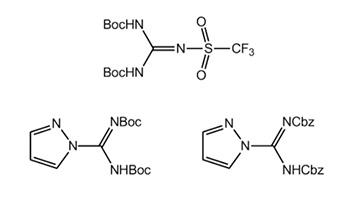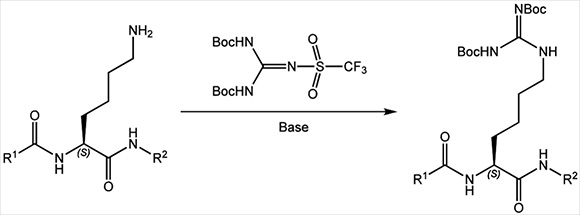Welcome to Iris Biotech
For better service please confirm your country and language we detected.

For better service please confirm your country and language we detected.

Thank you very much for your interest in our products. All prices listed on our website are ex-works, Germany, and may attract customs duties when imported.
You may/will be contacted by the shipping company for additional documentation that may be required by the US Customs for clearance.
We offer you the convenience of buying through a local partner, Peptide Solutions LLC who can import the shipment as well as prepay the customs duties and brokerage on your behalf and provide the convenience of a domestic sale.
Continue to Iris Biotech GmbHSend request to US distributorPublished on 03/12/2015

We now offer the standard guanylation reagent N,N'-Bis-(t-butyloxycarbonyl)-N"-triflylguanidine at both a very competitive price and our habitual high quality.
Additionally, for your convenience we offer N,N'-Bis-(t-butyloxycarbonyl)-1-guanylpyrazole as well as N,N-Bis(benzyloxycarbonyl)-1-guanylpyrazole.
Guanidine-containing molecules are interesting targets for medicinal chemists. A convenient method for the introduction of guanidino groups is the guanylation of amino groups.
One of the many uses of guanylation reagents is in the synthesis of Arginine-rich (or Arg-homolog-rich) peptides. The most common Arg-protecting group Pbf usually requires extended reaction times for deprotection. As a rule of thumb, the peptide chemist has to calculate one additional hour per Pbf group, which prolongs and complicates the synthesis of Arg-rich peptides.
An alternative strategy is the use of Mtt- or Mmt-protected Lysine. Both protecting groups can be removed quickly and under relatively mild reaction conditions, followed by the guanylation of Lysine to form Arginine. Similarly, homologs of Lysine such as Ornithine can be used to introduce the corresponding Arginine-homolog.

→ Our portfolio encompasses 166 Lysine building blocks, 68 different Ornithine building blocks, 76 Diamino Butyric Acid (Dab) variants and 91 Diamino Propionic Acid (Dap) variants.